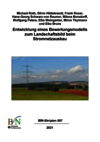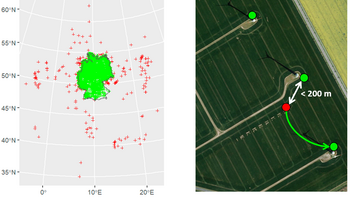The conversion of our energy systems involves new requirements for power distribution. When planning the expansion of the grid it is necessary to record and evaluate the negative effects on the landscape at a national level. This project is developing a method to do this.
The research project develops a nature conservation method to improve the evaluation and optimisation of corridor routing for overhead power lines. This takes account of the criteria of diversity, distinctiveness and beauty of the landscape prescribed in the Federal Nature Conservation Act (Bundesnaturschutzgesetz) as well as its recreational value.
The methodological approaches in the project aim to link to the state of the art in theory and practice. Existing methods for assessing the landscape and its recreational function were therefore examined in terms of their transferability and applicability to national level. This was based on the psychological and phenomenological definition of landscape following Nohl (2001). The evaluation of landscape quality and recreational function is based on GIS modelling, and calibrated and validated using reference assessments. The empirical surveys for this are carried out via an online questionnaire of a random sample of the population and by involving specialists in expert workshops. The assessment method developed in this way is then applied in the project across the whole of Germany.
The results present maps of the diversity, distinctiveness and beauty of the landscape for the whole country. A distinction is made between particularly valuable landscapes which are therefore worth conserving and those of an average or lower quality.
The evaluation model for the recreational function of the landscape is based on supply and demand. It is developed in parallel with the landscape evaluation approach and the results compared. This method should highlight those areas where the landscape has an important impact on the recreation potential.
Lastly, these methods will be used to assess how the landscape and the recreational function of a landscape are negatively affected by power lines and underground cables. The determining factors that negatively impact the recreational characteristic of the landscape will be identified and presented. This can provide a concept for identifying the conflict potential of expanding the grid and landscape, and applied using sample regions.
As part of the results, guidelines for implementation will be formulated for the strategic environmental assessment (SEA) for the Federal Requirements Plan (Bundesbedarfsplan, BBP) and for federal sectoral planning.

Entwicklung eines Bewertungsmodells zum Landschaftsbild beim Stromnetzausbau
BfN-Skripten 597 (2021)
"The Map of Beauty", documentary film by Marco Kugel, Germany 2018-2022, (premiere at the dokumentarfilmwoche Hamburg 2022).
Available in the 3sat-Mediathek until 16.05.2023
Nuertingen-Geislingen University (NGU)
Institute for Landscape and Environment (ILU)
Schelmenwasen 4-8, 72622 Nürtingen
Prof. Dr. Michael Roth
Tel.: +49 7022 201181
michael.roth(at)hfwu.de
Sina Röhner
Tel.: +49 7022 201192
sina.roehner(at)hfwu.de
University Stuttgart
Institute of Landscape Planning and Ecology (ILPÖ)
Keplerst. 11, 70174 Stuttgart
Dr. Hans-Georg Schwarz-von Raumer
Tel.: +49 711 685 84145
svr(at)ilpoe.uni-stuttgart.de
Bosch und Partner GmbH
Kantstr. 63 a, 10627 Berlin
Silvio Hildebrandt
s.hildebrandt(at)boschpartner.de
Dr. Wolfgang Peters
Tel.: +49 30 609 88 44-61
w.peters(at)boschpartner.de
Institut für nachhaltige Energie- und Ressourcennutzung (INER)
Hochwildpfad 47, 14169 Berlin
Federal Agency for Nature Conservation (BfN)
FG II 4.3 Nature conservation and renewable energies
Alte Messe 6, 04103 Leipzig
Friedhelm Igel
Tel.: +49 341 30977 165
Friedhelm.Igel(at)BfN.de
15.02.2023
Weiter

11.10.2022
Weiter

03.02.2022
Weiter
